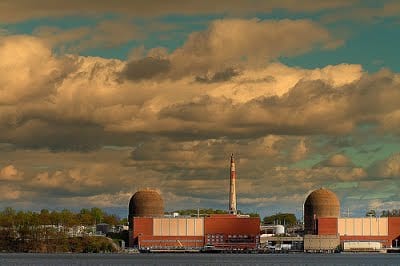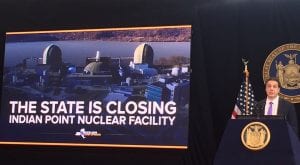As long as we have had nuclear bombs, the government and power companies have been trying to get the public interested in nuclear power. Nuclear energy seemed to be an efficient and clean source of power, but it can be risky too. New York’s main power company Con Ed (short for Consolidated Edison) entered the nuclear energy business in the 1960s, with mixed success.
A Nuclear Power Plant in Queens?

The site of the proposed nuclear power plant in Queens, right across the river from midtown Manhattan.
On December 19, 1962, Con Ed applied for a permit from the AEC to build a nuclear power plant in Queens on the East River between 37th and 38th Streets. The project was highly contested within the borough and the city. Many believed that it was foolish to build a nuclear power plant in the middle of such a populated area.
The plan was to have the plant under a giant concrete dome that would be sealed in the event of a meltdown. After much public outcry, Con Ed withdrew its plans in January 1964. David Lilienthal, former chairman of the AEC, said, “I regard this as a decision very much in the interest of the health and safety of Metropolitan New York.” (Clarfield, 1984, p. 356; Weaver, 1963; Mohr, 1964).
Troubles at Indian Point

Indian Point Nuclear Power Plant on the Hudson River
(Hope Abrams, April 18, 2010)
Con Ed came under fire again in 1980 when a water leak at its Indian Point Nuclear Power Plant—about 44 miles north of New York City—went unreported for a week in October. The previous year, the New York City Council had considered a resolution calling for the plant, whose first reactor opened in 1962, to be phased out. In response, antinuclear groups held a “rally for public safety” on January 24, 1981 at Con Ed’s headquarters at 14th St. and Irving Pl. (New York Times, 1980). The following year, the City Council considered a resolution calling for use the influence afforded by the City’s stock and pension funds to be used to “oppose the development of nuclear power and support alternative technologies.”

1981 flyer for protest against ConEd (Printed Ephemera Collection on Organizations, PE 036, Box 88, Tamiment Library/Robert F. Wagner Labor Archives.)
Following a lengthy campaign by environmental groups like Riverkeeper, in 2015, Resolution 694 was introduced in the New York City Council calling for Indian Point to be closed down. Two years later, New York’s Governor Andrew Cuomo announced that he had reached an agreement with the plant’s operator to have it cease operations by 2020, calling it a “ticking time bomb” (New York Times, 2017).

Announcement of closing Indian Point, 2017. (Riverkeeper).
Back to NYC Nuclear Archive Home
Next Page: A Nuclear-Free Harbor, 1980s-1990s
By Catherine Falzone and Matthew Bolton, 2018. Adapted from Nuclear New York archive with permission.
